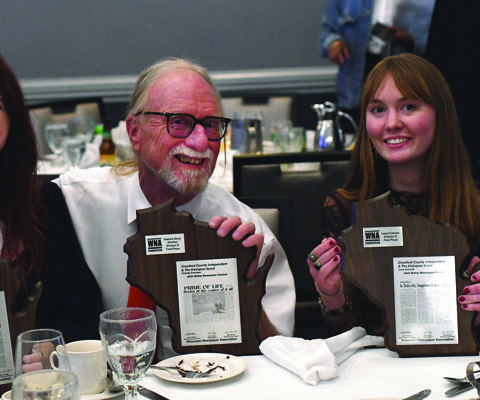More than 60 people attended a public meeting hosted by the Wisconsin Department of Transportation (DOT) to unveil its plans for bridge replacements on County Road T at Blue River.
Two bridges span the Wisconsin River at the location, connecting the towns of Blue River and Port Andrew. The current proposal is to close each bridge for a total of two years, starting in 2026.
Traffic would be re-routed to the nearest river crossings: Muscoda, which lies six miles to the east, or Boscobel, ten miles to the west.
That notion raised concerns for area residents who share fire protection, emergency medical services, and a school district in common on the north and south banks of the Wisconsin River.
“It’s going to add ten minutes to every 911 call,” explained Justin Degenhardt, who serves as Fire Chief for the Blue River fire district. “If someone is having a heart attack, ten minutes is going to make a hell of a difference,” he said.
Nearly 60 percent of the district’s protection area lies north of the river, according to Degenhardt. Currently, the bridges on County Road T serve as a vital lifeline for serving that property. Without that access point, Degenhardt said the Boscobel and Muscoda departments would effectively be first on the scene to any emergency north of the river.
“We would be mutual aid to Boscobel or Muscoda in our own fire district,” he said.
Budget buster
In addition to adding precious minutes to response time, carving the district in half would have financial consequences, too, according to Degenhardt.
Each municipality protected by the Blue River department pays into the $100,000 annual budget of the district.
“For two years they’re going to pay us to not cover them?” Degenhardt wondered. “That’s 58 percent of our budget. We might as well close shop and let Boscobel and Muscoda have the whole thing.”
School bus expense
Riverdale School District also spans both sides of the Wisconsin River. Students are currently transported by one of three bus routes to school in Muscoda. Those routes are already near capacity, according to District Administrator Jonathan Schmidt.
Closing the bridge would require a new bus route, Schmidt said.
“This would mean purchasing and maintaining an additional bus. A driver for the route would cost about $26,400 for two years. New buses are being priced out for next year at around $130,000, and we would use around 1,000 gallons of diesel fuel for this route per year,” he said.
Additional concerns
Residents in the area worry that the road closure will impact farmers who operate on both sides of the river and take a bite out of summer tourist traffic as well.
Angela Tanner owns the Citgo gas station and restaurant that sits across the bridge from Blue River in PortAndrew. She bought the business last July and said the closure would have an impact on her traffic— though how big an impact is unclear.
“We definitely have a high percentage of people who come across the bridge to get food,” Tanner said. “It’s going to hurt my business. I’ll be struggling to make ends meet.”
Cost a factor
The proposal to build new structures on the site of the existing bridges comes with savings over alternative plans—such as building the new bridge next to the old one, according to Derek Potter, who serves as project manager on the bridge replacement.
If the bridge changes location, he explained, routing traffic onto the bridges would mean reconfiguring the roads to create a safe approach.
“It certainly can be done,” he said. “It will be a completely new bridge no matter what, but costs start to snowball if you need to realign the road.”
At this time, Potter did not have a side-by-side cost comparison of the two approaches, but he said in a phone call that the cost of a road realignment would be “in the millions.”
Proposal may change
Potter emphasized that the department is in the early stages of planning—and that the point of the public input period is to refine the project based on local concerns.
“We’re early in the design phase,” he said. “Nothing is set in stone.”
Senator Howard Marklein, who represents both sides of the river in the seventeenth senate district, reported that his office received several calls following the public meeting, prompting his staff to reach out to the DOT.
“We were informed that the agency has heard the community loud and clear. They are going to explore options to keep the crossing open during construction.”
In an email, Marklein emphasized the importance of speaking up to weigh in on the DOT plan.
“Public meetings are clearly an important part of the DOT’s planning process, and they need to hear the personal, real-life examples of how the current plan will affect everyone who uses the bridges,” he wrote. “The plan is not done; now is the time to communicate.”
How to weigh in
The DOT website has a page dedicated to the project, which includes photographs and schematics of the initial proposal.
The page includes a comment form that can be printed and mailed. Additionally, citizens can email comments to derek potter@dot.wi.gov or ryan.mckane@wsp.com.
The public comment period lasts 30 days, ending on February 26, 2024. The project page can be found at: https://wisconsindot. gov/Pages/projects/ by-region/sw/countyt-bridges/ default.aspx






